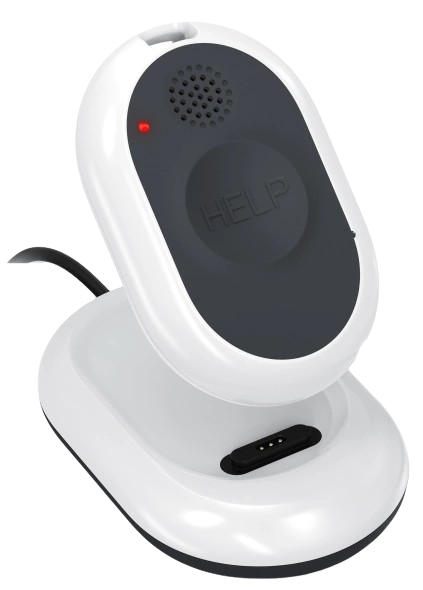Canada's legal and policy frameworks are divided between federal and provincial/territorial jurisdictions. Nova Scotia, like many provinces, follows Canada’s federal Occupational Health and Safety Code when it comes to lone worker policies but also offers its own region-specific guidelines. For employers in Nova Scotia, this page outlines practical strategies and provincial recommendations for supporting lone workers in the workplace. Our Guide To Lone Worker Safety Policy And Legislation In Nova Scotia In Nova Scotia, working alone can be hazardous, requiring employers to take proactive steps to comply with provincial legislation and federal regulations. Ensuring the safety of lone workers is a critical responsibility under these laws.
This page highlights the key aspects of managing lone workers in Nova Scotia, focusing on compliance with the Occupational Health & Safety Code (OHS) and effective hazard control measures.
On This Page
Our Guide To Lone Worker Safety Policy And Legislation In Nova Scotia
In Nova Scotia, working alone can be hazardous, requiring employers to take proactive steps to comply with provincial legislation and federal regulations. Ensuring the safety of lone workers is a critical responsibility under these laws.
This page highlights the key aspects of managing lone workers in Nova Scotia, focusing on compliance with the Occupational Health & Safety Code (OHS) and effective hazard control measures.
How Nova Scotia Defines A Lone Worker
Nova Scotia does not explicitly define a "lone worker" but addresses the concept with various policies and recommendations. A lone worker is understood to be someone working by themselves in a situation where no one is immediately available to assist in case of an emergency. This includes circumstances like remote work locations, situations where violence is a risk, or when working without routine interaction with others.
Employing A Lone Worker In Nova Scotia
Best practices in Nova Scotia include conducting hazard assessments to identify and mitigate risks for lone workers, and by implementing appropriate control measures such as training, communication protocols, and physical security.
Employers should also establish violence prevention plans and ensure that lone workers have access to first aid training or means to summon help quickly. For remote locations, employers must maintain a written first aid remote location plan. Overall, adherence to regulations like the Internal Responsibility System (IRS) and Violence in the Workplace Regulations helps create a safer environment for lone workers.
Learn How You Can Protect Your Employees With Loneworker.com

With Loneworker.com you can be equipped with the knowledge and the means to protect your employees and protect your business. Contact us today to learn more about how Loneworker.com can protect you and your employees.
How The Safe Lone Worker App Can Protect Nova Scotia Lone Workers And Employers
An important part of keeping your lone workers safe is providing quick and easy communication and monitoring in the event of an emergency.
With the Safe Lone Worker App, you can easily monitor your employees' while they are carrying out their responsibilities, even if they are travelling alone. The app works in tandem with a man down alert button that can be pressed in the event of an emergency. If the button is pushed, the lone worker will be immediately put into contact with a monitoring center that can send help immediately and contact the employer.
Nova Scotia Lone Worker Policies
The content below has been included as a direct reference for lone worker policies as provided by Nova Scotia. This content has been included to serve as more detailed information and an easy reference point. This information is provided for your convenience, but should not be taken as legal advice. We encourage you to conduct your own research into the laws and regulations of your jurisdiction before making any decisions.
Occupational Health and Safety Legislation – Lone Workers Information guide
The Occupational Health and Safety Division (Division) has received a number of queries lately regarding the legality of workers working alone. While there are several regulations that pertain to lone workers, there are no OHS regulations that preclude someone from working alone in any workplace, except in very specific cases such as confined space entry, where an attendant is required.
The following sections of the Occupational Health and Safety Act, and its regulations pertain to lone workers*:
OHS Act s. 13 (1)(a) – “Every employer shall take every precaution that is reasonable in the circumstances to ensure the health and safety of persons at or near the workplace”.
This section requires the employer to conduct a hazard assessment and, in consultation with the Joint Occupational Health and Safety Committee (committee) or Health and Safety representative (representative), if any, put into place such reasonable measures required to provide for the health and safety of employees and anyone else that may be present at or near the workplace. In the case of a lone worker, this would require an assessment of the risks of working alone and reasonable control measures to minimize these risks, such as training, communications, physical security, etc.
OHS Act s. 17(2) – “Where an employee believes that any condition, device, equipment, machine, material or thing or any aspect of the workplace is or may be dangerous to the employee's health or safety or that of any other person at the workplace, the employee shall
- (a) immediately report it to a supervisor;
- (b) where the matter is not remedied to the employee's satisfaction, report it to the committee or the representative, if any;
- (c) where the matter is not remedied to the employee's satisfaction after the employee reports in accordance with clauses (a) and (b), report it to the Division.
Employees should be aware of their own right and responsibility to report working conditions they believe may be hazardous to their own health or safety or that of others. This is an important aspect of the Internal Responsibility System (IRS) which is the foundation of our OHS legislation. Employees are not only expected, but they are obligated to report health and safety concerns.
OHS Act s. 28(2)(e) – Where the business is large enough to be required to have a written occupational health and safety program it must include:
“a hazard identification system that includes
- (i) evaluation of the workplace to identify potential hazards,
- (ii) procedures and schedules for regular inspections,
- (iii) procedures for ensuring the reporting of hazards and the accountability of persons responsible for the correction of hazards, and
- (iv) identification of the circumstances where hazards must be reported by the employer to the committee or representative, if any, and the procedures for doing so;
This requires that, for workplaces large enough to require a program, it must include a hazard identification system to evaluate potential hazards, procedures for reporting them and accountability for correcting them, a system of monitoring for hazards, etc. This may be a method by which it could be pointed out to employers, who may not perceive working alone as a hazardous situation, that they should use their program procedures to address this specific concern.
Violence in the Workplace Regulations s. 5 (1) – An employer must conduct a violence risk assessment for each of their workplaces in accordance with this Section to determine if there is a risk of violence in the workplace and prepare a written report concerning the violence risk assessment detailing the extent and nature of any risk identified by the assessment.
s. 7 (1) – “An employer must establish and implement a workplace violence prevention plan for each workplace for which a significant risk of violence is identified through a violence risk assessment or that an officer orders a plan for.”
The Violence in the Workplace Regulations only apply to certain types of business and the full regulation must be consulted to determine applicability and required action. In general, those businesses that deal with clientele, such as retail stores, health care facilities, educational facilities, police and correctional services, financial services, transportation services, etc. are required to conduct a violence risk assessment and establish/implement a plan to prevent the incidence of violence.
The full regulation should be consulted to determine if it applies to the workplace in question. While this regulation does not apply only to lone workers, it may be a consideration in some circumstances.
Learn How The Lone Worker Monitoring Device Works.

By using a Safe Lone Worker Man Down alert you can monitoring your employees and keep them safe even while they are travelling or working on their own.
Our devices are equipped with cellular and GPS technology to provide service all across Canada and the United States of America.
Contact us today to get your Safe Lone Worker Man Down Alerts for you and your business.
First Aid Regulations s. 5 (1) – “Where a full time employee is employed in any type of employment that regularly requires the employee to work where there is no one available who could administer first aid or summon assistance within a reasonable length of time, the employee shall hold a valid emergency first aid certificate.”
This requirement ensures that consideration for first aid response is made for either the employee or a person at the workplace where an employee regularly works alone. While it applies only to “full time” employees, which is defined in the regulation as someone who works 30 hours per week, averaged over a 4 week period, it would be prudent for an employer to consider this as a requirement for any lone worker. The alternative is to ensure that there is a method of “summoning assistance within a reasonable length of time”.
First Aid Regulations s. 18 (1) – “Where a worksite or worksites are in a remote location or locations, the employer, or where the worksite or worksites are part of a project, the constructor, shall maintain a written first aid remote location plan”.
The full regulation should be consulted if there is a situation where this section may apply. While this regulation does not apply only to lone workers, it may be a consideration in some circumstances.
* This information is intended to help you to understand the key health and safety laws that apply to people working alone but there may be others that apply at your workplace. It is your responsibility to understand the law. Please consult the Occupational Health and Safety Act and regulations for the full set of laws that may apply to lone workers at your workplace.
References
Occupational Health and Safety Division. Occupational Health and Safety Legislation – Lone Workers Information Guide. Nova Scotia Government Website.
Government of Canada, Canadian Centre for Occupational Health and Safety. Working Alone - General. 10 May 2024.
Loneworker.com is an aggregate resource and is not directly affiliated with government policies, legislation, or guidelines. Our site is intended to gather and display information for your use, but you are encouraged to conduct your own research.
Nova Scotia Lone Worker Resources

Nova Scotia Government
Anywhere in Nova Scotia
- 1-800-670-4357
Deaf or hard of heating (TTY)
- 1-877-404-0867

Lone Worker And Employment Facts In Nova Scotia
527,700 People Are Employed In Nova Scotia
Health Care And Social Assistance And Professional, Scientific And Technical Services Make Up The Majority Of Nova Scotia’s Employment Industry
Affordable Monitoring For Lone Workers In Nova Scotia

-
 Monitoring Your Employees' Safety
Monitoring Your Employees' Safety
-
 GPS Tracking And Monitoring
GPS Tracking And Monitoring
-
 Man Down Panic Alerts
Man Down Panic Alerts
-
 24/7 Protection Anywhere
24/7 Protection Anywhere
Lone Worker Legislation
Lone Worker Safety Policies And Legislation By Province
-
 Alberta Provincial Safety Policies And Legislation
Alberta Provincial Safety Policies And Legislation
-
 British Columbia Provincial Safety Policies And Legislation
British Columbia Provincial Safety Policies And Legislation
-
 Manitoba Provincial Safety Policies And Legislation
Manitoba Provincial Safety Policies And Legislation
-
 New Brunswick Provincial Safety Policies And Legislation
New Brunswick Provincial Safety Policies And Legislation
-
 Newfoundland and Labrador Provincial Safety Policies And Legislation
Newfoundland and Labrador Provincial Safety Policies And Legislation
-
 Nova Scotia Provincial Safety Policies And Legislation
Nova Scotia Provincial Safety Policies And Legislation
-
 Ontario Provincial Safety Policies And Legislation
Ontario Provincial Safety Policies And Legislation
-
 Prince Edward Island Provincial Safety Policies And Legislation
Prince Edward Island Provincial Safety Policies And Legislation
-
 Quebec Provincial Safety Policies And Legislation
Quebec Provincial Safety Policies And Legislation
-
 Saskatchewan Provincial Safety Policies And Legislation
Saskatchewan Provincial Safety Policies And Legislation
-
 Northwest Territories Provincial Safety Policies And Legislation
Northwest Territories Provincial Safety Policies And Legislation
-
 Nunavut Provincial Safety Policies And Legislation
Nunavut Provincial Safety Policies And Legislation
-
 Yukon Provincial Safety Policies And Legislation
Yukon Provincial Safety Policies And Legislation







